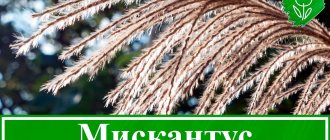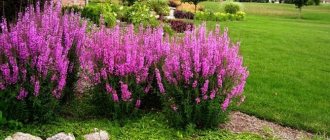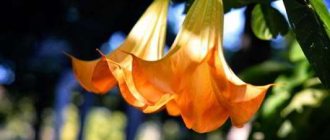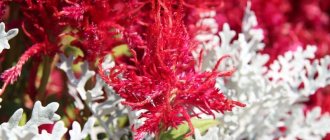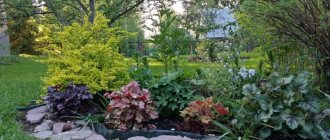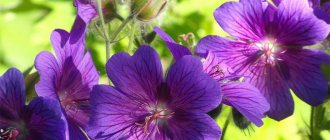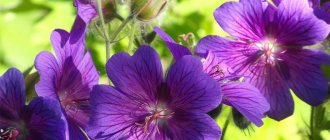This healing plant attracts not only its properties, but also its beautiful delicate flowers. By growing echinacea in your own flower garden, you can not only take advantage of its healing properties, but also create intricate compositions from different varieties of this flower.
It is not difficult to grow it in your flowerbed, and it will delight you with numerous large flowers of various shades: white, pink, yellow and orange. When flowers bloom, they attract bees and butterflies with their scent, which constantly circle over mature flowering bushes. Read about annual flowers for the garden here.
Types and varieties of Echinacea
A total of nine species of this plant have been found in nature and each has its own differences that give it its charm. The most common flowers are Echinacea strange and Echinacea purpurea.
Echinacea is strange
This species has no cultivars as it is the only one of its kind and has yellow petals that rival the summer sun.
Echinacea purpurea
In this species, the buds in bloom reach a diameter of 12 cm. The core has a brown tint and bends strongly upward into a cone. In nature, it is often found in forests and fields, and can even grow on mountain slopes.
This is an undemanding flower that will appreciate minimal care and will delight others with its blooming. Purple echinacea has different varieties:
- Echinacea variety Cranberry Cupcake is one of the attractive varieties that has a center with double petals of bright pink color.
- Variety The King - the name of the kings was not given to this variety in vain. It resembles a field chamomile with a tall stem, reaching two meters in height, with flowers of a reddish hue, the diameter of which sometimes reaches 15 cm.
- Variety White Swan - the name of the variety can be translated as “white swan” and it is given, as can be understood due to the white flowers similar to chamomile. The diameter of the opened buds reaches 14 cm.
- Echinacea variety Indiaca - has a stem height of 75 cm, flowering begins in early summer and ends in September. The buds that open on this variety come in pink and orange shades.
- Variety Magnus - has a stem 85 cm high, begins flowering in mid-summer and continues until mid-October. The buds in bloom have a crimson hue to the flower with a brown center.
- Echinacea variety Julia is a new hybrid belonging to the “Butterfly Kisses” series. This is a dwarf species, barely reaching 40 cm. It has bright orange flowers that begin to bloom in early summer and do not stop blooming throughout the season.
Echinacea purpurea
Echinacea in landscape design
It can be used as a wonderful decorative element, as its large flower heads, reminiscent of daisies, go well with phlox and asters. Actually, they are combined with any plants; it is especially beautiful to plant them against the background of coniferous trees, interspersing them with juniper.
Echinacea - planting and care
When planting echinacea in your flowerbed, you don’t have to expect in the first year of life that it will be a large and flowering bush. In the first year, the future bush develops a root system, and a rosette of leaves forms on the surface. The first flowering will occur only next summer.
Flowering begins in mid-July and lasts throughout the warm season. In order to create good growth conditions for a plant, it is necessary to adhere to a number of certain rules:
- From the very beginning, young echinacea is planted on the sunny side of the flowerbed, since even in partial shade the plant does not survive, and gradually loses its leaves and dies;
- The composition of the soil can be any, but if the soil consists of only sand, then garden soil with compost or humus must be added to the planting hole, otherwise, in the absence of nutrients in the soil, the bush may not bloom;
- Timely removal of weeds will be responded to by abundant flowering;
- Will respond well to fertilizing, which you can make with your own hands, or can be purchased in specialized stores;
- Buds that have passed their flowering period should be removed with scissors and not torn off with your hands, since the stem is not brittle. It is necessary to prune at a height of 10-15 cm from the ground so that the flowering of the bush does not stop;
- If the bush grows large, it must be divided into at least two or three parts and planted in the right places. This rejuvenation of the plant will prolong its life, and it will be able to bloom for a long time.
- Since the plant loves moisture, evening watering is necessary, especially during the hot months of summer;
- In October, when frosts begin, you need to cut off the drying stems of the plant, and after another month, cover them with dry leaves and twigs so that the wind does not blow away the leaves.
If a sufficiently mature mother bush was purchased for planting, then planting will not cause problems at all and flowering, albeit not so lush, can be expected this year.
To plant such a bush, a hole of 40x40 cm is dug and nutrients in the form of humus and peat are added there in equal parts. An adult bush is planted at the same depth as it was planted before. When replanting, you must try not to destroy the earthen lump, so as not to damage the roots.
Growing conditions
Echinacea is easy to grow and prefers sunny or lightly shaded locations. It grows well in slightly shaded positions, but blooms much less there.
Echinacea grows better on soils:
- fertile;
- humus;
- moderately humid;
- well drained.
These perennials do not grow well in dry, sandy, poor soil. Due to its branched root system (underground rhizomes), Echinacea does not tolerate transplantation well.
Echinacea propagation
You can propagate this beautiful flower:
- Using seeds;
- By dividing the bush.
Seed propagation
You can purchase seeds of a new variety of Echinacea and grow a completely new bush on your site. Seeds can be planted immediately in open ground, but unfavorable germination conditions can do their job, and the seeds or seedlings will die. And what has sprouted will have a poor root system and damaged flowers. As a result, this method of planting seeds is practically not used.
Therefore, it is better to sow seeds for seedlings in February. To do this, seeds are planted in prepared small bowls with loose nutrient soil and lightly crushed with sifted sand. The temperature in the room should be about 15 degrees Celsius.
If the seeds have not grown at the end of the week, do not worry, the germination period for seeds is 1.5 months, which is why they are sown so early for seedlings. When an Echinacea seed germinates, the sprout is very delicate and requires some care.
He needs constant moisture without flooding and warmth. Therefore, it is better to raise them at home, and at the end of May send them to a permanent place of residence in a flower bed. But the soil in the hole should have average moisture without stagnant water, but the plant cannot tolerate drought.
After this, you need to water it on time and do not forget to loosen the soil around the young Echinacea bush. But if at the end of May the bush has not grown enough and looks weak, then it can be left in a pot at home, only if possible, take it out into the fresh air and grow it in this way until the end of September. And only then plant it in a flowerbed. With such a planting, intense heat will not destroy the bush with young branches.
Collecting Echinacea Seeds
To obtain well-ripened seeds, select only those buds that fully correspond to the variety, cut with scissors so that the stems can be tied and hung to dry.
But at the same time, it is worth remembering that the buds themselves are wrapped in a piece of gauze so that when they dry completely, the echinacea seeds do not spill out onto the floor.
You should not wrap it in cellophane, since the middle is wet before drying and will not dry in the bag, but will be covered with gray rot.
After a while, when all the seeds are already in a gauze bag, they are taken out and dried for a month on the table. After which they can be placed in a plastic bag or jar and stored in the refrigerator until spring.
Dividing the bush
This method is used in April before the onset of heat. The plant has a well-developed root system and, by propagating it in this way, you can get wonderful results - cuttings with good roots and stems that can take root well in a new place.
To do this, the old mother bush is dug up and divided with a bayonet shovel so that each young seedling has roots and stems. You can add a handful of ash and a little rotted humus to the dug hole under the bush.
Then the bushes are placed so that the root collar is at the same level as before digging up the mother bush. The roots are straightened in different directions and evenly laid in different directions for balance and gradually bury the hole with earth.
After all the manipulations, lightly trample the soil around the bush and water it abundantly. But, if at this time there is intense heat, then you can make a temporary shelter over the planted rosette of echinacea leaves from twigs placed over the bush in the form of a hut and cover it with mowed grass on top.
Such a shelter will help maintain shade over the leaf blades and reduce water evaporation. This advice may be especially useful for residents of the southern regions of Russia, since already in May the thermometer can exceed 35 degrees.
In this easy way you can propagate the plant, both in spring and autumn, it all depends on the region where it will happen. In the southern regions, it is recommended to plant any flowers in September, and in the northern regions, all planting is done in the spring. Different periods are given for the plant to take root and fully adapt to the new location.
Echinacea diseases
Actually, this is not the flower to which diseases attach, but during a long rainy season, rot or powdery mildew may appear. But after treatment with special chemicals purchased at the garden center, all this will disappear and the flower will be healthy.
Sometimes it can be affected by viral diseases, during which the peduncles and the flowers themselves can change greatly, the leaf plates turn yellow and fall off.
Since viral diseases cannot be cured, the plants are urgently dug up and burned off-site so as not to contaminate the soil in your garden. And the very place where the diseased plant grows is spilled with a dark pink solution of potassium permanganate. And it is advisable not to plant anything in that place for a couple of years.
Sometimes you can notice pests such as bugs and slugs on the plant. All this is collected by hand, but to reduce the number of slugs, you can scatter either nut shells or boiled egg shells around the flowers. This will interfere with gastropods moving on the ground.
Description of the plant
Thus, Echinacea is a herbaceous perennial.
The plant is tall, as it can reach a height of 150 cm. The leaf blades are not the same everywhere. At the base of the root, large oval-shaped foliage is located on petioles. The foliage along the stem is sessile and lanceolate in shape.
Photo of echinacea
The inflorescences are large baskets, the central part of which consists of numerous tubular flowers and edging petals of red, pink, white, and brown colors. After withering, an achene with four sides is formed in place of the flower.
Echinacea - beneficial properties and contraindications
This beautiful flower not only has a lot of charm, but also has many medicinal properties. The plant itself contains a lot of:
- Saccharides;
- Tannins;
- Flavonoids;
- Saponinov;
- Organic acids;
- Essential oils and much more.
This collection of various components gives the plant the right to take part in hematopoiesis, in the formation of bones, teeth, nails, and hair.
Therefore, many antiviral and antimicrobial drugs are made based on echinacea; decoctions made from this herb have antifungal and anti-inflammatory effects, and also strengthen the immune system with long-term use.
Various preparations are prepared from the Echinacea plant;
- Decoctions.
- Squeeze out the juice.
- Tinctures.
- Extracts.
The plant is not only common in various countries, but is also gaining popularity due to its healing properties. It is believed that in terms of its healing properties, Echinacea is not inferior to a plant such as ginseng. The herb is used to treat sore throats and tonsillitis.
According to the latest research by our scientists, preparations made from an extract from Echinacea purpurea increase the leukocytes in the blood by fifty percent. And also with constant use of drugs based on echinacea, the protective properties of the liver increase.
Preparing the tincture
Place cut echinacea flowers in a jar at the very edge and fill the entire contents with vodka. Place all this for 40 days in a dark and cool place. After which the tincture is filtered and you can take 15 drops per 70 g. water. Everything is taken 30 minutes before eating. This helps with depression, fatigue or any infectious diseases.
Root decoction
To do this, the roots are crushed and one tablespoon is poured into 300 grams. water. And boil in a water bath for 30 minutes. After cooling completely, strain and take two tablespoons four times a day 30 minutes before meals. This helps to avoid chronic fatigue, colds and infectious diseases.
Echinacea infusion is very useful to take in the winter season. Since we are usually full of people sick with the flu or other viral diseases, the tincture will help strengthen the immune system, relieve fatigue and stimulate physical activity. Here's how to prepare such a tincture.
Tincture
Flowers of the plant in the amount of 60 g. Place in a container of suitable size and pour in a liter of boiling water. After boiling it all for 10 minutes, wrap it tightly in a towel and let it brew for five hours. In this case, the mass of useful elements in the tincture will reach its highest limit. After straining the tincture, you can add sugar or honey and take 100 g. three times a day.
All these effective properties of the plant have always been known to people, and it is good to take it in areas with a polluted atmosphere. All drugs speed up a person’s metabolic processes, and his body begins to cope with various diseases.
But you can’t take medications all the time; you need to take breaks so that the human body can take advantage of what it received from nature. The break between doses of the drug should be at least a month.
If you yourself were unable to prepare an alcoholic tincture of Echinacea in time, it can be purchased at any pharmacy as prescribed by a doctor.
Preparations made from this plant are suitable for people of all ages. After all, it never hurts to boost your immunity and cheer up your mood in winter in a natural way. Since at the end of winter the human body receives less vitamins and begins to get tired quickly.
Therefore, by taking the tincture with water or tea, we help our body fight “hibernation.” But, like all drugs, there are contraindications.
Contraindications
Like all medicinal plants, Echinacea has its contraindications. It, like any drug made from medicinal herbs, should not be taken without consulting your doctor. Since it can cause an allergic reaction in the person receiving it. It should not be taken by pregnant and nursing mothers, with leukemia, tuberculosis, or sclerosis.
Having seen this beautiful flower at least once during its bloom, it is impossible to forget it, so it sinks into a person’s soul. The seemingly fragile flower is not only beautiful, but also remarkably helps to improve human health.
Compound
In folk medicine, rhizomes and flower baskets of Echinacea are used. The first ones are collected in late autumn, when the plant loses its leaves, the second ones - during flowering. These parts of echinacea contain many active biological compounds useful for humans:
- polysaccharides - arabinoramnogalactans and heteroxylans, biological enzymes, flavonoids, hydroxycinnamic acids;
- echinocin and echonolone are active antioxidants;
- essential oil – up to 0.5% in flowers, and up to 0.23% in roots;
- tannins;
- macro- and microelements – calcium, cobalt, molybdenum, zinc, selenium.
The roots of the plant contain more glycosides, resins, and phytosterols. The share of inulin, a natural prebiotic, reaches 6%, glucose – 7%. A remarkable fact: betaine is isolated from the rhizome - up to 0.1%. This substance prevents strokes and heart attacks.
Expert advice - video
Medicinal properties of Echinacea
Echinacea to boost immunity. The easy way. Blank
Read about adenium here.
- Whitefly - pest control in the garden
- Cineraria - smoky beauty
- Do-it-yourself swing for a summer house
- Phytophthora of tomatoes: signs and methods of control
- Early spring flowers in the garden
- How to get rid of ants - all methods of control
- Rose diseases and their treatment
- DIY crafts from plastic bottles for the garden and cottage
- DIY country veranda
- Lobelia - planting and care
- Photos of beautiful flowers
- How to get rid of spider mites on an orchid
Application in garden design
Echinacea is in demand in the garden because it can beautifully decorate the garden. It becomes an excellent background for other plants or decorates the foreground of a flower garden. Bushes also create beautiful borders, frame gazebos, paths, and alleys. An interesting solution is to combine echinacea with cereals, asters, and loosestrife. If you plant the plant in containers, it can decorate stairs and patios. Cut buds are used to form beautiful dry bouquets.


